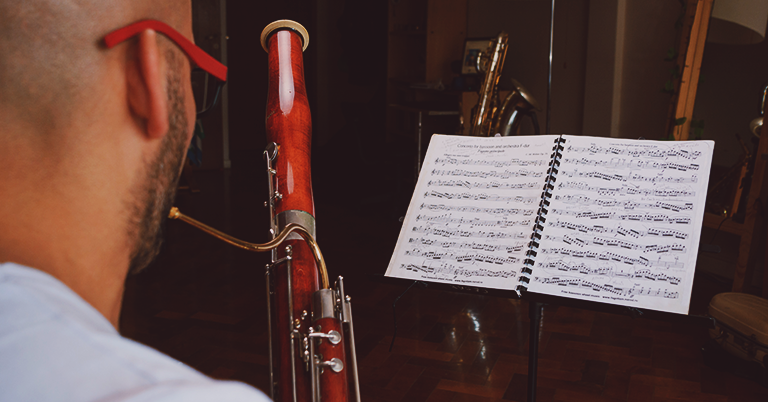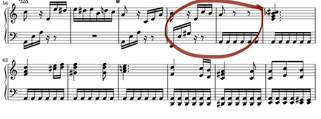
Ashlee is a verified Fons by MakeMusic provider. Fons is a studio management platform that offers a full suite of business tools for private music teachers. Click here to learn more.
Learning a new piece can be exhilarating. That initial excitement when you decide to tackle a new composition is often a joyous experience. You feel connected to the piece, and the motivation to bring it to life surges through you. However, as you start learning and practicing, you might find yourself in the dreaded middle stage.
You know you’re in the middle stage of learning a piece if:
- You’re comfortable with some aspects like fingering and note reading, yet you haven’t quite reached the stage where you can play through the piece with freedom, fluidity, and musicality.
- You have an idea of what you’d like to do dynamically and musically, but you’re unable to execute your ideas without errors.
- It feels like you know some of the piece at a deep level, but some parts of the piece feel really uncomfortable.
- You have logged dozens of practice hours for the piece, but the feeling of “flow” seems elusive.
Unfortunately, this is often the stage where hobby musicians either throw their hands up in the air, admit defeat and no longer work on the piece, or accept the wrong notes and pauses as a part of the piece and don’t try to improve the piece anymore.
I don’t want this for you.
Fortunately, there are effective strategies to help you navigate this challenging stage and progress toward your goal of playing the piece with freedom and musicality.
Step #1: Focus on Transitions
One of the most common pitfalls that holds musicians back in the middle stage is neglecting transitions. It’s common to approach practice by starting at the beginning of the piece and working through it methodically. While this approach has its merits, it often overlooks the critical aspect of transitioning between different sections of the music.
Consider a simple example of a piece that has 2 contrasting sections. It’s at the juncture of these sections where you’re likely to face challenges. Many musicians diligently practice each section but neglect to practice transitioning between the sections. The result? When attempting to play the entire piece seamlessly, they get stuck because they can’t smoothly navigate the shifts from one section to the next.
So, how do you address this issue? The solution is to practice the transitions deliberately. Take the last measure of one section and the first measure of the next section and practice them back-to-back. By linking these two sections together, you’re effectively smoothing out the transition, making it less likely to trip you up during a full playthrough. This targeted approach can significantly reduce pauses and errors, helping you progress through the middle stage more effectively.
Take for example the transition between the A section and the C section in the famous piece, “Für Elise”, by Ludwig Van Beethoven happening between measures 59 and 60.

You would first start by practicing measure 59 and measure 60 by themselves as a two measure chunk. Once that felt easy and you could play it with consistent accuracy, you could practice measures 58, 59, 60 and 61. Once that felt easy and you could play it with consistent accuracy, you would practice measures 57, 58, 59, 60, 61, and 62. You are essentially zooming in on the exact measures where the transition occurs, and then adding measures around the transition to work it seamlessly back into the piece.
This way of practicing not only ensures that you work on the transition, it also creates a complicated puzzle for your brain to solve when you work on measures out of order. It’s an effective tool for getting sections of music deeper into your memory and it helps you remember the transitions much better.
Step #2: Practice at Half Tempo
This tip might be met with resistance by some musicians, but it’s a powerful technique to enhance your playing. The idea is simple yet effective—slow down. Significantly. To implement this strategy, use a metronome and set it to half the normal tempo of the piece. Yes, it might feel frustratingly slow, and you may initially struggle with boredom. However, bear with it because practicing at half tempo yields huge results.
If your piece is already at a slow tempo, you might need to set your metronome to a smaller valued note in order to achieve this. For example, if your piece is supposed to be played at 50 bpm and you are trying to practice at half tempo, that means you’ll need to set your metronome to 25 bpm. Most metronomes don’t go as slow as 25 bpm, so you have two options. You can keep the metronome at 50 bpm but have the click represent half the note value, so if 50 bpm was representing quarter notes, now have it represent eighth notes. Alternatively, you can look up specific metronome speed backing tracks on youtube and practice with one of them. Here is a 30 minute video of 25 bpm on repeat.
When you practice at a slower pace, you create more mental space to focus on various aspects simultaneously. It’s like giving your brain room to breathe and process information more thoroughly. This approach not only helps you identify and correct mistakes but also encourages you to develop a musical interpretation even at a slower pace. When you first try practicing at half tempo, don’t get discouraged if it feels more difficult than playing at full tempo. This is just your brain getting used to a different speed.
Stick to it and force yourself to play the piece as accurately, musically, and technically consistent as possible. Over time, you’ll find that playing at half tempo becomes less tedious and more insightful.
Step #3: Shifting Mindsets
Learning a piece requires two distinct mindsets at different stages of your practice.
In the initial stages, you need a vigilant mindset. This means being hyper-aware of your mistakes and areas that need improvement. You meticulously identify errors and work diligently to correct them. This mindset helps build a solid foundation for your piece, ensuring that you start with a clean slate and minimize errors from the outset. This mindset requires that the highest goal is consistent accuracy. This means that you work as hard as possible to ensure that you make as few mistakes as possible during your practice sessions.
However, as you progress and aim to play the piece seamlessly from start to finish, you must shift your mindset. This transition involves developing the ability to let go of your mistakes. Unlike the vigilant mindset, where you aim to notice and correct every mistake, the letting go mindset encourages you to continue playing, even if you make a mistake.
Many musicians struggle with this shift. They become so accustomed to fixing mistakes that when they encounter an error during a full playthrough, it disrupts their flow, leading to pauses or even restarting from the beginning. To overcome this challenge, it’s crucial to consciously practice shifting your mindset. Set aside specific practice sessions where your goal is to play through the piece without stopping, regardless of minor errors.
I recommend that musicians spend the bulk of their practice time practicing with consistent accuracy as the goal, but that they do one or two playthroughs at the end of the practice session where they shift their mindset and make the goal to let the mistakes go for the sake of playing through the piece musically with flow. Think of it as 85% consistent accuracy, 15% let it go flow.
By developing this ability to let go and move forward, you’ll play with fewer pauses, more freedom, and increased fluidity. It’s a different mindset, but it’s a vital skill in your musical journey.
Bonus Tip: Building a Solid Foundation with Layering
A bonus technique that can significantly impact your progress with all the stages of learning a piece is layering. Layering involves a unique practice method that focuses on building a solid foundation right from the beginning. By adopting this approach, you can potentially shorten the middle stage of your learning process.
Layering is a practice technique that encourages a systematic approach to learning a piece. It involves breaking the piece down into its essential elements and progressively adding layers of complexity. Here’s a brief overview of how to incorporate layering into your practice routine:
- Basic Foundation: Start by practicing the piece in its simplest form. Focus solely on the fundamental elements, such as fingering, basic rhythm, and note reading. This initial stage sets the groundwork for your performance.
- Intermediate Layer: Once you’ve mastered the basics, add an intermediate layer. This may involve dynamics, phrasing, and expression. Gradually, you’ll enhance your understanding of the musical nuances within the piece.
- Advanced Layer: In the final stage of layering, introduce advanced elements, such as tempo variations, ornamentations, and intricate dynamics. By this point, you’ll have a comprehensive grasp of the piece, allowing you to play with depth and musicality.
The beauty of layering is that it systematically builds your skills, ensuring a solid foundation before advancing to more complex aspects of the piece. Consequently, when you reach the middle stage, you’ll encounter fewer challenges, as you’ve already developed a strong musical foundation from the very beginning stages of learning the piece.
For a more detailed exploration of the layering technique and how to implement it effectively, check out this video tutorial that dives even deeper into the topic.
MakeMusic Cloud is an online practice platform that provides the solutions you need to make your practice fun, engaging, and efficient. Accurate, real-time assessment helps you identify spots that need practice and shows your progress through the learning process. Use the looping feature to dig into transitions and trouble spots, and adjust the tempo of the built in playback and metronome for more efficient practice. MakeMusic Cloud will power your practice and help you grow as a musician.